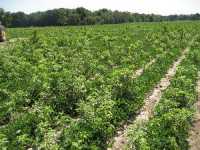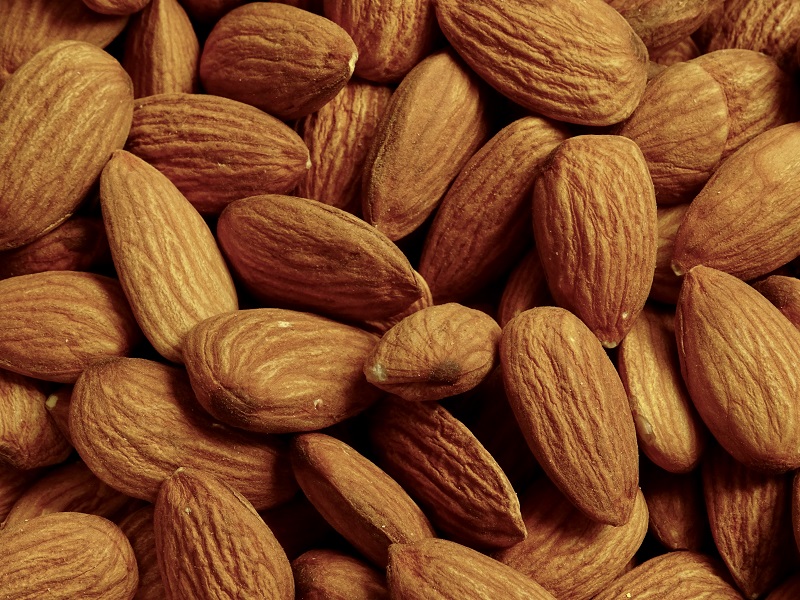Palmer Amaranth: A Weed To Watch

Palmer amaranth has become one of the most troublesome weeds in the Southeast. According to records, Glyphosate Resistant (GR) palmer amaranth was identified in only one county in Georgia in 2004. Now, it is in virtually every Georgia county where cotton is grown. In the last two years, Palmer amaranth has spread at an alarming rate in north Florida. It is suggested that this weed was initially introduced to row-crop farms from contaminated equipment. But now that this weed has become established, it is likely that it will continue to spread into pastures, hay fields and vegetable production sites as well.
Palmer amaranth grows rapidly, produces tens of thousands of seed per plant, and is highly likely to develop herbicide resistance. Resistance in Palmer amaranth is related to the tremendous amount of seeds that plants produce. Every seed is another opportunity for that one in a million mutation that will confer herbicide resistance. Herbicides do not cause resistance, they just ensure that resistant individuals live says Dr. Jason Ferrell, Weed Extension Specialist with the University of Florida. Different populations of this weed have developed herbicide resistance to glyphosate, ALS inhibitors (imidazolinones, sulfonylureas), dinitroanilines herbicides (pendimethalin, ethalfluralin, trifluralin) and photosystem II inhibitors (atrazine, diuron, etc). While no current populations of Palmer amaranth are known to be resistant to all these herbicides, they have the potential to become resistant to any herbicide that is repeatedly used.
Pesticide resistance can be defined as the ability of an insect, fungus, weed, rodent, or other pest to tolerate a pesticide that once controlled it. Populations of animals and plants possess the ability to respond to sustained changes or stresses in their environment in ways that enable the continued survival of the species. Environmental stresses include physical factors like temperature or humidity, biological factors such as predators, parasites, or pathogens, and environmental contaminants. In any population, a small percentage of individuals will be better able to respond to new stresses because of unique traits or characteristics that they possess. Consequently, those individuals will survive and reproduce (Fishel, 2010).
Palmer amaranth has a deep taproot that may give it more access to water and nutrients than many commonly grown crops. This taproot makes it difficult to remove Palmer amaranth by hand. Broken-off stems as small as 1 inch can resprout, flower and produce seed. Consequently, when Palmer amaranth is present in a field it has the potential to reduce yields; in cotton one Palmer amaranth per ten feet of row can reduce yields by 10% (Morgan et. al. 2001) and in a full-season crop like peanut, 1 plant per three feet of row can reduce yields by 28% (Burke et.al 2007 ).
A decade ago, Palmer amaranth was identified in Levy County and traced back to a field were cottonseed hulls were fed to stocker cattle. It took time for the weed to be properly identified. The gravity of its presence was not immediately known and eventually it spread to other parts of the county. According to Anthony Drew, Extension Agent in Levy County, had they known the repercussions of Palmer amaranth back then, they could have treated the first site where it was identified with an organo-auxin herbicide and controlled it. As a result of this incident, University of Florida Specialists and Agents started working with the farmers to develop strategies for Palmer amaranth control in different crops.
For growers that do not have this weed in their fields it is imperative that they learn how to identify it so that they can act as soon as they see it in their fields.
Following IPM Principles
1. Identification
Although this plant is in the amaranth family, its growth rate and biology is very different from the other types of pigweeds such as red root pigweed or “careless weed” found in Florida. For a complete guide on identification of palmer amaranth go to Amaranthus palmeri “Palmer amaranth” http://edis.ifas.ufl.edu/ag346 authored by Dr. Jason Ferrell and Sergio Morichetti from the University of Florida.
Key characteristics that differentiate palmer amaranth from other pigweeds:
• Petioles as long as or longer than the leaf blade.
• Long terminal inflorescences.
• Prominent white veins on the lower surface of the leaf.
• Hairless leaves.
• Faster growing than other pigweeds.
2. Monitoring the population
One Palmer amaranth plant has the potential to produce more than 500,000 seeds in one season. Often, the first plants to show up in a field are ignored thus resulting in the potential of hundreds of thousands of plants the next year. Palmer amaranth produces male and female flowers on different plants; for seed to develop, pollen from a male needs to be carried by the wind to a female plant. If pollen from a glyphosate-resistant male palmer amaranth plant fertilizes a susceptible female, a portion of the offspring will also have the resistant trait. Research from the University of Georgia has shown that pollen from glyphosate-resistant males can travel at least 1000 feet in the field and fertilize susceptible females. Seeds can also move resistance around when getting caught up in harvest equipment, mowers or trapped in tractor tires. To slow down the spread of resistance, don’t allow plants to reach reproductive maturity and produce pollen and seed. This means that farmers need a season-long plan to prevent palmer amaranth from spreading.
The number of Palmer amaranth plants in a field will dictate what strategy you follow. If a small number of plants are present in the field, the best thing to do is continue with your regular spray program and if you have escapes pull them before they produce seed. For fields that are infested with Palmer amaranth, assume these are resistant and implement changes to your herbicide program. Contact your local county Extension agent for current herbicide recommendations.
3. Developing a goal
This year’s seeds become next year’s weeds. Effective weed management for palmer amaranth means removing all plants from a field before they reach reproductive maturity to prevent seed production. Acceptable control can be achieved if the farmer stays on task and has an aggressive, proactive approach to controlling Palmer amaranth. Anthony Drew considers that if all goes well in the field, you can achieve 85% control in peanut fields, consequently reducing the seed population for the next year. This means that it will take time to get Palmer amaranth under control once a field becomes infested.
Ideally eradication of Palmer amaranth would be the best case scenario. Eradication is the total elimination of a pest from a designated area. However, because of the complexity of controlling Palmer amaranth suppression is a more realistic goal. Suppressive pest control methods are used to reduce pest population. The methods chosen usually do not eliminate all pests or weeds but reduce their populations to a tolerable level or to a point below an economic injury level.
4. Putting IPM to work
Here are some considerations:
A. Start with a weed free field before crops are planted.
B. Monitor fields throughout the season, be timely with herbicide applications. Contact your local County Extension Agent for crop specific recommendations. The rapid growth rate of this plant makes the window of time available to make effective herbicide applications very short. One of the main challenges is that it is hard to control palmer amaranth using herbicides once it has reached four inches in height. Herbicides tend to be more effective on smaller, rather than larger plants.
C. Post harvest control is key to reducing plant populations. Options include mowing, tillage, herbicide use and planting cover crops when land is fallow in the summer.
D. In the fall as daylight decreases plants can flower in as little as 3 to 4 weeks and produce seed 2 to 3 weeks later.
E. Planting winter cover crops. High biomass winter cover crops have shown to suppress palmer amaranth due to reduced sunlight and physically interfering with seedling emergence.
F. If a heavy infestation exists, moldboard plowing may be used to bury seed below the optimal germination/emergence zone. Palmer amaranth seeds are very small and can only survive in the soil for 18 months to 3 years. Deep tillage operations should only be used infrequently so that the deeply buried seeds can die and decompose.
5. Evaluating the results
As you fight Palmer amaranth in the field, it is essential to keep good records of what products have been sprayed in order to trace back resistance problems.
Early identification of Palmer amaranth is essential to reduce the time and cost associated with controlling this weed. According to Dr. Jason Ferrell, Palmer amaranth is among the most difficult-to-manage weeds that we have ever encountered in the deep South, but it is not impossible to contain. Scout your fields and watch your weed control program closely so that you can correct a problem before the population gets out of control. Proper identification, scouting and diligence are the keys to victory over this weed.
Credits
Burke, I.A., Schroeder, M., Thomas, W.E. & Wilcut, J.W. (2007) Palmer Amaranth Interference and Seed Production in Peanut. Weed Technology: April 2007, Vol. 21, No. 2, pp. 367-371
Ferrell, J., Brecke, B. & Smith, C. 2010. Control of Palmer Amaranth in Agronomic Crops. http://edis.ifas.ufl.edu/ag348
Fishel, F. 2010. Applying Pesticides Correctly. 7th Edition.
Morichetti, S. & Ferrell, J.2010. Amaranthus palmeri “Palmer Amaranth”.
http://edis.ifas.ufl.edu/ag346
Morgan, G.D,, Baumann, P. and Chandler, J. (2001) Competitive Impact of Palmer Amaranth (Amaranthus palmeri) on Cotton (Gossypium hirsutum) Development and Yield1. Weed Technology: July 2001, Vol. 15, No. 3, pp. 408-412.
Sosnoskie, L.M., Webster, T.M., Culpepper, A.S. & Kichler, J. 2011. The Biology and Ecology of Palmer Amaranth: Implications for Control. http://mulch.cropsoil.uga.edu/weedsci/HomepageFiles/PalmerBiologyEcology.pdf.









